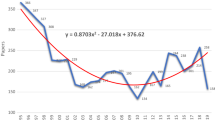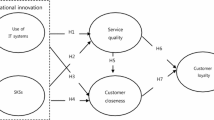Abstract
This study examines the effects of quality management (QM) activities and sociotechnical systems (STS) on internal customer (employee) experience and organizational performance in healthcare organizations. The proposed research model and developed hypotheses were tested using structural equations modeling based on the data collected from 239 employees who had more than three years of work experiences at general hospitals in South Korea. The results of the study indicated that QM activities have positive effects on STS components, which in turn help improve internal customer experience and organizational performance. The study results provide insights to healthcare organizations for sustainable hospital management strategies.

Similar content being viewed by others
References
Ahire S, Golhar D, Waller M (1996) Development and validation of TQM implementation constructs. Decis Sci 27(1):23–56
Amabile T (1998) How to kill creativity. Harv Bus Rev 76(5):76–87
Anderson S, Smith J (2016) An empirical examination of the impact of tri-dyadic fit on the service experience. J Serv Manag 27(3):299–319
Barclay D, Higgins C, Thompson R (1995) The partial least squares (PLS) approach to causal modeling: personal computer adoption and use as an illustration. Technol Stud 2:285–309
Baxter G, Sommerville I (2010) Socio-technical systems: from design methods to systems engineering. Interact Comput 23(1):4–17
Beltrán-Martín I, Roca-Puig V, Escrig-Tena A, Bou-Llusar J (2008) Human resource flexibility as a mediating variable between high performance work systems and performance. J Manag 34(5):1009–1044
Bitner M, Booms B, Mohr L (1994) Critical service encounters: the employee’s viewpoint. J Mark 58(4):95–105
Blomqvist A, Leger P (2005) Information asymmetry, insurance, and the decision to hospitalize. J Health Econ 24(4):775–793
Brown T (2006) Confirmatory factor analysis for applied research. The Guilford Press, New York
Cahill D, Warshawsky R (1995) Beyond competence: unconditional guarantees as a customer-service tool. J Custom Serv Market Manag 1(3):67–77
Chaudary S, Zafar S, Salman M (2015) Does total quality management still shine? Re-examining the total quality management effect on financial performance. Total Qual Manag Bus Excell 26(7–8):811–824
Cleveland Clinic (2015) Serving our present, caring for our future progress in community and global citizenship. Cleveland Clinic, Cleveland, OH
Cleveland Clinic Newsroom (2020) Cleveland Clinic named No. 2 hospital in the world by Newsweek (March 6, 2020). https://newsroom.clevelandclinic.org/2020/03/06/cleveland-clinic-named-no-2-hospital-in-the-world-by-newsweek/. Accessed 7 Apr 2020
Denton G, White B (2000) Implementing a balanced-scorecard approach to managing hotel operations. Cornell Hotel Restaurant Admin Q 41(1):94–107
Douglas T, Fredendall L (2004) Evaluating the Deming management model of total quality in services. SATIS 35(3):393–422
Emery F, Trist E (1960) Socio-technical systems. In: Churchman C, Verhulst M (eds) Management science: models and techniques 2, pp 83–97
Ferris G, Arthur M, Berkson H, Kaplan D, Harrell-Cook G, Frink D (1998) Toward a social context theory of the human: resource management-firm performance relationship. Hum Resour Manag Rev 8(3):235–264
Fornell C, Larcker D (1981) Evaluating structural equation models with unobservable variables and measurement error. J Mark Res 18:39–50
Garvin D (1988) Managing quality: the strategic and competitive edge. Free Press, New York
Geels F (2004) From sectoral systems of innovation to socio-technical systems∶ insights about dynamics and change from sociology and institutional theory. Res Policy 33(6–7):897–920
Goldstein S, Schweikhart S (2002) Empirical support for the Baldrige award framework in US hospitals. Health Care Manag Rev 27(1):62–75
Grönroos C (1990) Service management and marketing: managing the moment of truth in service competition. Lexington Books, Lexington
Haeckel S, Carbone L, Berry L (2003) How to lead the customer experience to create a total brand experience, firms must provide the right directions. Market Manag 12(1):18–23
Harter J, Mann A (2017) The right culture: not just about employee satisfaction. Workplace, GALLUP
Heskett J, Sasser W, Schlesinger L (1997) The service profit chain: how leading companies link profit and growth to loyalty, satisfaction, and value. The Free Press, New York
Hudadoff P (2009) The customer value proposition: differentiation through the eyes of your customer. Applied Product Marketing LLC
Kinman G (2009) Emotional labour and strain in ‘front-line’ service employees: does mode of delivery matter? J Manag Psychol 24(2):118–135
Kristianto Y, Ajmal M, Sandhu M (2012) Adopting TQM approach to achieve customer satisfaction: a flour milling company case study. TQM J 24(1):29–46
Kull T, Ellis S, Narasimhan R (2013) Reducing behavioral constraints to supplier integration: a socio-technical systems perspective. J Supply Chain Manag 49(1):64–86
Lam M, O’Donnell M, Robertson D (2015) Achieving employee commitment for continuous improvement initiatives. Int J Oper Prod Manag 35(2):201–215
Lee D (2018) Strategies for technology-driven service encounters for patient experience satisfaction in hospitals. Technol Forecast Soc Chang 137(12):118–127
Lee D (2020) Impact of organizational culture and capabilities on employee commitment to ethical behavior in the healthcare sector. Serv Bus 14(1):47–72
Lee S, Lim S (2018) Living innovation: from value creation to the greater good. Emerald Publishing Limited, Bingley
Lee S, Lee D, Kang C (2012) The impact of high-performance work systems in the health care industry: employee reactions, service quality, customer satisfaction, and customer loyalty. Serv Ind J 32(1):17–36
Lee S, Lee D, Olson D (2013) Health care quality management using MBHCP excellence model. Total Qual Manag Bus Excell 24(2):119–137
Lee D, Hong K, Kim N (2016) Effects of hospital leadership, organizational systems, and ESWOS on medical error reduction. Serv Bus 10(1):159–177
Lee D, Yu S, Yoon S (2019) Analysis of hospital management based on the characteristics of hospitals: focusing on financial indicators. Glob Business Finance Rev 24(3):1–13
Lopez-Valeiras E, Gomez-Conde J, Lunkes R (2018) Employee reactions to the use of management control systems in hospitals: motivation vs. threat. Gac Sanit 32(2):129–134
McColl-Kennedy J, Vargo S, Dagger T, Sweeney J, van Kasteren Y (2012) Health care customer value cocreation practice styles. J Serv Res 15(4):370–389
McFadden K, Henagan S, Gowen C III (2009) The patient safety chain: transformational leadership’s effect on patient safety culture, initiatives, and outcomes. J Oper Manag 27(5):390–404
Merlino J, Raman A (2013) Health care’s service fanatics: how the Cleveland clinic leaped to the top of the patient-satisfaction surveys. Harv Bus Rev 91(5):108–116
Myers J (2012) Going above and beyond: improving internal customer satisfaction. Infect Control Today 2012:1–5
Nunnally J (1978) Psychometric theory, 2nd edn. McGraw Hill, New York
Oakland J (2011) Leadership and policy deployment: the backbone of TQM. Total Qual Manag Bus Excell 22(5):517–534
Osman M, Rosnah M, Ismail N, Tapsir R, Sarimin M (2004) Internal customer satisfaction in ISO 9001 certified manufacturing companies. Int J Eng Technol 1(2):179–187
Pasmore W, Sherwood J (1978) Sociotechnical systems: a sourcebook. University Associates, La Jolla
Pine B, Gilmore J (1998) Welcome to the experience economy. Harv Bus Rev 76(6):97–105
Psomas E, Jaca C (2016) The impact of total quality management on service company performance: evidence from Spain. Int J Qual Reliab Manag 33(3):380–398
Sampson D, Terziovski M (1999) The relationship between total quality management practices and operational performance. J Oper Manag 17:393–409
Schneider B, Macey W, Lee W, Young S (2009) Organizational service climate drivers of the American customer satisfaction index (ACSI) and financial and market performance. J Serv Res 12(1):3–14
Shostack L (1977) Breaking free from product marketing. J Mark 41(2):73–80
Shostack L (1984) Designing services that deliver. Harv Bus Rev 62(1):133–139
Slater S, Narver J (1994) Does competitive environment moderate the market orientation performance relationship? J Mark 58:46–55
Smith J, Karwan K, Markland R (2009) An empirical examination of the structural dimensions of the service recovery system. Decis Sci 40(1):165–186
Smith J, Fox G, Ramirez E (2010) An integrated perspective of service recovery: a socio-technical systems approach. J Serv Res 14(4):439–452
Smith J, Anderson S, Fox G (2017) A quality system’s impact on the service experience. Int J Oper Prod Manag 37(12):1817–1839
Survey Research Center (2011) Guidelines for best practice in cross-cultural surveys (4th). Survey Research Center, Institute for Social Research. University of Michigan, MI
Tekin P, Erol R (2017) The internal and external customer focused process improvement and the performance analysis studies in healthcare systems. J Ind Eng Manag 10(3):407–430
Verhoef P, Lemon K, Parasuraman A, Roggeveen A, Tsiros M, Schlesinger L (2009) Customer experience creation: determinants, dynamics and management strategies. J Retail 85(1):31–41
Vincoli J (1991) Total quality management and the safety and health professional. Prof Saf 36(6):27–32
Walker O, Ruekert R (1987) Marketing’s role in the implementation of business strategies: a critical review and conceptual framework. J Mark 47:12–25
Wolf J (2018) Elevating the discourse on experience in healthcare’s uncertain times. Patient Exp J 5(3):1–5
Yoon S, Lee D (2019) Artificial intelligence and robots in healthcare: what are the success factors for technology-based service encounters? Int J Healthcare Manag 12(3):218–225
Zeithaml V, Bitner M, Gremler D (2013) Services marketing, integrating customer focus across the firm (6th). McGraw-Hill Irwin, New York
Zhang D, Linderman K, Schroeder R (2014) Customizing quality management practices: a conceptual and measurement framework. Decis Sci 45(1):81–114
Zomerdijk L, Voss C (2010) Service design for experience-centric services. J Serv Res 13(1):67–82
Acknowledgements
This work was supported by INHA UNIVERSITY Research Grant (INHA-65327).
Author information
Authors and Affiliations
Corresponding author
Additional information
Publisher's Note
Springer Nature remains neutral with regard to jurisdictional claims in published maps and institutional affiliations.
Rights and permissions
About this article
Cite this article
Lee, S.M., Lee, D. Effects of healthcare quality management activities and sociotechnical systems on internal customer experience and organizational performance. Serv Bus 16, 1–28 (2022). https://doi.org/10.1007/s11628-022-00478-9
Received:
Accepted:
Published:
Issue Date:
DOI: https://doi.org/10.1007/s11628-022-00478-9




